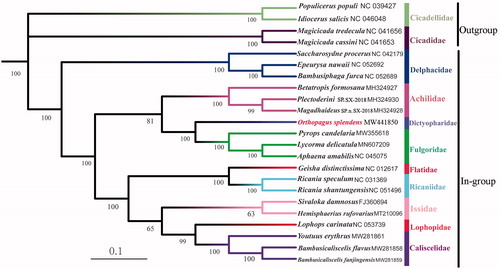Abstract
The first complete mitochondrial genome of a dictyopharid planthopper, Orthopagus splendens (Germar, 1830) (Hemiptera: Fulgoroidea: Dictyopharidae) is sequenced. The 15,349 bp long complete mitogenome contains 13 protein-coding genes (PCGs), 22 tRNA genes, two rRNA genes, and 1 A + T-rich region with an arrangement identical to that observed in most insect mitogenomes (GenBankNo. MW441850). All PCGs start with ATN, and end with TAN or single T (nad1, nad5, and atp6). A phylogenetic analysis places O. splendens as sister to Fulgoridae confirming a sister relationship between Dictyopharidae and Fulgoridae.
The planthoppers of the family Dictyopharidae Spinola, 1839 (Hemiptera: Fulgoromorpha), currently groups 740 species in 160 genera (Bourgoin Citation2020). Divided into two subfamilies and 19 tribes, the species Orthopagus splendens (Germar, 1830) belongs to the Dictypharinae Spinola, 1839, Orthopagini Emeljanov 1983 (Muir Citation1923; Metcalf Citation1946; Song et al. Citation2018; Bourgoin Citation2020). We report here the first complete mitochondrial genome (mitogenome) for this planthopper family.
Mitogenome DNA was extracted from a single female specimen collected from Xinliangtian Village, Guiding County, Guizhou province, China (107°23′E, 26°57′N) on the 11 August 2020. after DNA was extracted from the hind legs, a specimen was deposited at the Institute of Entomology, Guizhou University (Xiangsheng Chen, [email protected]) under the voucher number GUGC-20200811-Y1. The mitogenome sequences were obtained by next-generation sequencing method (Illumina HiSeq X 10), assembled using Geneious version 10.2.2 (Kearse et al. Citation2012) , annotated, and conducted using MITOZ (Meng et al. Citation2019) and deposited in GenBank, accession number MW441850. IQtree (Kumar et al. Citation2016) was used for phylogenetic analyses and to construct the maximum likelihood (ML) tree based on 13 PCGs, 22 tRNA, and two rRNA of 23 species (including four outgroups from Cicadelloidea and Cicadoidea), and 18 related planthopper species from different Fulgoroidea families.
The complete mitogenome of O. splendens is 15,349 bp in length and consists of 13 protein-coding genes (PCGs), two ribosomal RNA genes (rRNAs), 22 transfer RNA genes (tRNAs), and one large non-coding region (D-loop: [A + T]-rich region). The D-loop part is 1181 bp, taking place between 12S rRNA and trnI. The overall bases composition is A: 30.2%, T: 47.2%, C: 14.6%, and G: 8%. AT skew ((A − T)/(A + T)) and GC skew ((G − C)/(G + C)) are 0.22, −0.294, respectively. All the 13 PCGs started with ATN, ended with TAN or a single T (nad1, nad5, and atp6) residue. The length of 22 tRNA ranged from 59 bp(trnS) to 70 bp (trnK). Genes of 16S rRNA and 12S rRNA are 1177 and 729 bp, respectively.
The phylogenetic tree obtained confirms the monophyly of Fulgoroidea and most nodes are recovered with the higher ultrafast bootstrap (UFB = 100). As expected from both morphological (Emeljanov Citation1979; Song et al. Citation2018) and molecular analyses (Urban and Cryan Citation2009; Song and Liang Citation2013), the dictyopharid species appears in a sister relationship with Fulgoridae, both in an unexpected clade sister to Achilidae: (Achilidae+(Dictyopharidae + Fulgoridae)). While already previously observed by Song and Liang (Citation2013) and Wang et al. (Citation2019), it is probably due to a limited sampling effect.
Disclosure statement
No potential conflict of interest was reported by the authors.
Data availability statement
The data supporting the findings of this study are openly available in the National Center for Biotechnology Information (NCBI) at https://www.ncbi.nlm.nih.gov, accession number MW441850. The associated BioProject, SRA, and Bio-Sample numbers are PRJNA726041, SRS8798664, and SAMN18920653, respectively.
Additional information
Funding
References
- Bourgoin T. 2020. FLOW (Fulgoromorpha Lists on the Web): a world knowledge base dedicated to Fulgoromorpha. Version 8. [accessed 4 May 2021]. http://hemiptera-databases.org/flow/.
- Emeljanov AF. 1979. Problema razgranichenhiya semeïstv Fulgoridae i Dictyopharidae (Homoptera, Auchenorrhyncha). Trudy Zool Inst Akademii Nauk SSSR. 82:3–22.
- Kearse M, Moir R, Wilson A, Stones-Havas S, Cheung M, Sturrock S, Buxton S, Cooper A, Markowitz S, Duran C, et al. 2012. Geneious Basic: an integrated and extendable desktop software platform for the organization and analysis of sequence data. Bioinformatics. 28(12): 1647–1649.
- Kumar S, Stecher G, Tamura K. 2016. MEGA7: molecular evolutionary genetics analysis version 7.0 for bigger datasets. Mol Biol Evol. 33(7):1870–1874.
- Meng G, Li Y, Yang C, Liu S. 2019. MitoZ: a toolkit for animal mitochondrial genome assembly, annotation and visualization. Nucleic Acids Res. 47(11):e63–e63.
- Metcalf ZP. 1946. General catalogue of the Hemiptera, Fasc. IV. Fulgoroidea, Part 8 Dictyopharidae. Northampton (MA): Smith College, Northampton, MASS; p. 246.
- Muir F. 1923. On the classification of the Fulgoroidea (Homoptera). Proc Hawaiian Entomol Soc. 205(5):247.
- Song N, Liang AP. 2013. A preliminary molecular phylogeny of planthoppers (Hemiptera: Fulgoroidea) based on nuclear and mitochondrial DNA sequences. PLoS One. 8(3):e58400.
- Song ZS, Bartlett CR, O’Brien LB, Liang AP, Bourgoin T. 2018. Morphological phylogeny of Dictyopharidae (Hemiptera: Fulgoromorpha. Syst Entomol. 43(4):637–658.
- Urban JM, Cryan JR. 2009. Entomologically famous, evolutionarily unexplored: the first phylogeny of the lanternfly family Fulgoridae (Insecta: Hemiptera: Fulgoroidea). Molecular Phylogenetics and Evolution 50: 471–484.
- Wang W, Huang Y, Bartlett CR, Zhou F, Meng R, Qin D. 2019. Characterization of the complete mitochondrial genomes of two species of the genus Aphaena Guérin-Méneville (Hemiptera: Fulgoridae) and its phylogenetic implications. Int J Biol Macromol. 141:29–40.

